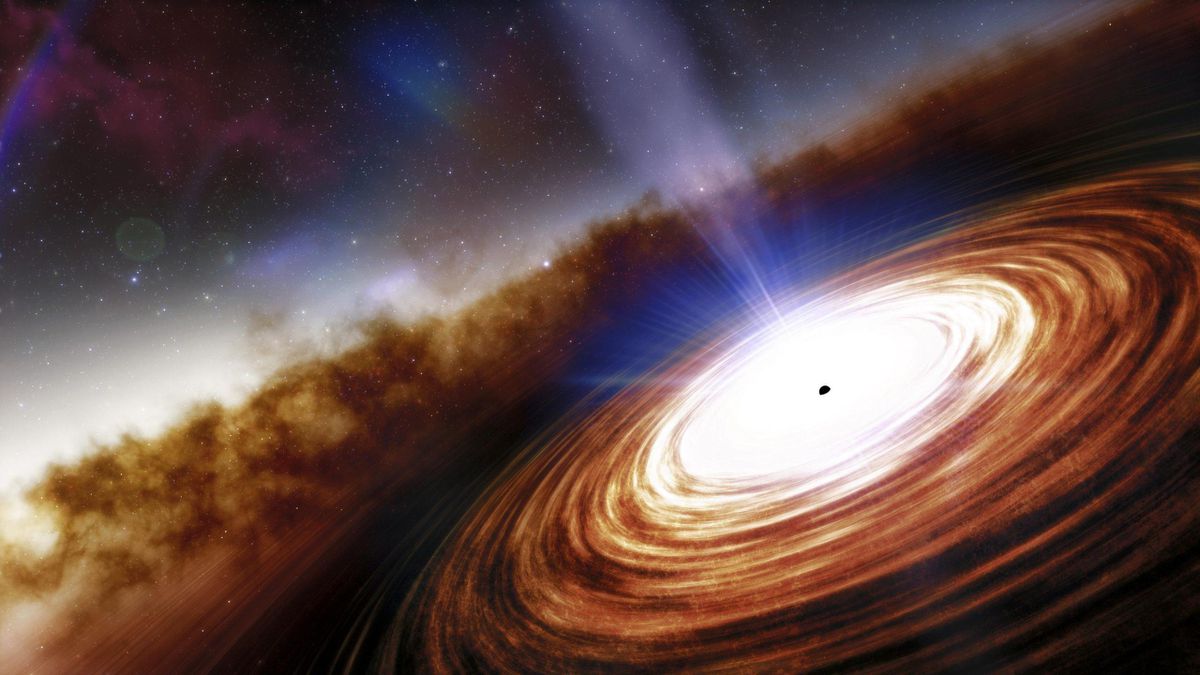
A quasar named J0313-1806 is the most distant one thus discovered, providing a window on the … [+]
Credit: NOIRLab/NSF/AURA/J. da Silva
Lurking at the center of all large galaxies lies a monster – a black hole with a mass equal to millions or even billions of times heavier than the sun. Astronomers do not understand in detail how such objects came to be, although they do have ideas. These ideas range from the improbable possibility that they assembled from the collisions of smaller black holes, to the much more likely, but still mysterious, possibility that they grew directly from clouds of gas shortly after the universe began. Figuring out the truth will require that astronomers study super massive black holes shortly after the universe began. And, at the January 2021 annual meeting of the American Astronomical Society, researchers announced the discovery of the most distant (and therefore oldest) super massive black hole found thus far.
Directly seeing a black hole is very difficult. In fact, it has been accomplished only once, with the observation of one at the center of a galaxy 65 million light years from Earth. However, there is a way to indirectly see a black hole, and that is when matter is falling into it. As matter (most commonly in the form of gas) falls into a black hole, the gas is heated by friction. The temperatures of this gas are high enough for it to glow. And it doesn’t glow just a bit. Light emitted by a “feeding” super massive black hole is bright enough to be seen across billions of light years. Historically, the name for a feeding supermassive black hole is a “quasar,” but more recently the are referred to as “active galactic nuclei,” or AGNs.
The newly discovered quasar is the most distant one found to date. Called J0313-1806, it is located so far away that it took thirteen billion years for the light to travel to Earth. We are seeing it as it was just 670 million years after the universe began.
The black hole powering the quasar has a mass equivalent to 1.6 billion times heavier than our sun. In contrast, the black hole at the center of the Milky Way galaxy is a mere four million times the mass of the sun.
J0313-1806 is ten trillion times brighter than our sun, meaning that it pours out a thousand times more energy than the entire Milky Way galaxy. It is this brightness that allows it to be seen at such huge distances.
Supermassive black holes like J0313-1806, and the galaxies that host them, are very important for researchers trying to understand how the universe evolved. It is thought that the first stars began to shine about 200 million years after the Big Bang, and primordial galaxies became established about 400 million years after the universe began. Explaining the existence of a supermassive black hole at the early date of only 670 million years after the Big Bang is a real challenge to astronomers.

Inside the dome of the Victor Blanco telescope located in Chile. This facility is used to study … [+]
REIDAR HAHN
It required the input of several facilities to establish that J0313-1806 is an early quasar, including the Victor M. Blanco Telescope and the Gemini South telescope, based in Chile, combined with the Gemini North telescope and W.M. Keck Observatory, located on top of Mauna Kea, in Hawaii.
In addition to determining the mass of the super massive black hole, astronomers also observed a jet of gas emanating from it. This jet is moving at the astonishing speed of 20% the speed of light, fast enough to orbit the Earth in half a second. It may seem counterintuitive for a black hole to emit matter, but as matter spirals down into the black hole and heats up, powerful magnetic fields are generated that guide some of the matter to the poles of the black hole and this matter is blasted out into space.
This jet of hot gas disturbs the environment of the host galaxy, causing star formation. Astronomers estimate that the rate of star formation in the galaxy hosting J0313-1806 is about two hundred times higher than in the Milky Way. Researchers can use this galaxy as a laboratory to study star formation in the early universe.
Scientists will continue to study both J0313-1806 and the galaxy hosting it to better understand a crucial period in the history of the universe.
This article is auto-generated by Algorithm Source: www.forbes.com


